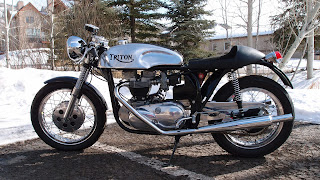Dresda Triton
Few bikes could live with a good Triton’s 650cc Triumph performance in a straight line, and the same thing was true of its Norton Featherbed chassis’s handling ability on a twisty road.
Classical Triton features included low bars, long alloy tank, humped seat, big front drum, lightweight alloy wheel rims - plus, of course, the all- important blend of Triumph motor and Norton Featherbed frame.
Of all the bikes built under the parallel twin-cylinder format that dominated motorcycling in the 1960s, the Triton embodied the best of both worlds: the straight-line performance of Triumph’s powerful engine, and the handling ability of the legendary Norton Featherbed chassis. Tritons were built by numerous firms and individuals, using a variety of engines and chassis from those two major manufacturers. The combination was so successful that the Triton came to be regarded as a marque in its own right.
The Triton’s precise origins are unclear, partly because several enterprising individuals built similar hybrids in the mid-1950s. As early as 1954, London-based racer and engineer Doug Clark used the chassis of a blown-up Manx Norton single to house a 650cc Triumph engine. Clark rode the resultant twin on both road and racetrack. But after the bike had been noticed by a Triumph employee while at Silverstone circuit, Clarke received a letter from the factory threatening legal action if he continued with the project. He also claimed that Triumph told its London dealers to refuse to sell him engine parts.
The appeal of the Triton concept in the early 1960s was easy to understand. Triumph’s twin had held a straight-line advantage ever since Norton’s new Model 7 had been outpaced by the Speed Twin in 1949. Ten years later, Triumph’s 650cc Tiger 110 was a good lOmph (16km/h) faster than its 600cc rival the Norton Dominator 99. By the time Norton’s more powerful 650SS arrived in 1962, Triumph’s reputation for speed was secure. But handling was a different matter. Norton’s
These two Tritons were both built by Dresda Engineering, the famous London firm run by racer Dave Degens. The model on the left has a wideline Featherbed frame; the bike on the right is based on a frame from a genuine Manx Norton. One of the lasting attractions of the Triton is that no two bikes are identical.
Featherbed frame and Roadholder forks were notably stronger than their Triumph equivalents, and also came with an impressive racing pedigree.
Those contrasting reputations helped to establish the Triton as the 'dream ticket’ for road and track. The bikes varied in their details, featuring different fuel tanks, instruments, seats, suspension parts, and exhaust systems. As well as Triumph’s popular twin-carburettor 650cc Bonneville engine, Triton builders used 500cc motors (and later the 750cc unit too). The Featherbed frame could be used in its original Wideline or later Slimline form, as well as being sourced from the Manx single.
Specialist firms including Dresda Autos of west London began building complete Tritons and also conversion kits, some based around Featherbed replica frames of their own construction. The Triton received a boost in 1965 when Dresda boss Dave Degens, a top racer, rode one to victory in the 24- hour endurance event at Montjuic Park in Barcelona, with co-rider Rex Butcher. The winning machine was then ridden at high speed from London to Edinburgh and back by a journalist from The Motor Cycle, generating further interest.
Degens also won production races on Tritons, resulting in objections from riders of more standard machinery, but the controversy merely served to generate even more publicity for the hybrid machines. By the mid-1960s several firms were producing complete Tritons, and many others were offering engine plate kits plus parts including fuel tanks and seat units. Degens estimates that Dresda alone built more than 500 Tritons over the next few years, plus many replica frames.
A Triton was still a classy combination in 1969, when Motorcycle Mechanics tested a hotted-up Dresda special at 126mph (203km/h), but the boom was almost over. As well as the many high-quality hybrids, there had been more than a few Tritons built with limited expertise and a second-rate blend of Triumph and Norton components. But the legend of the Triton lived on, especially at Dresda, where Degens continued to build, sell and race Tritons into the 21st century.
Specification Dresda Triton (1965)
- Engine Air-cooled ohv four-valve Triumph parallel twin
- Capacity 649cc (71 x 82mm)
- Maximum power 50bhp @ 6500rpm
- Transmission Four-speed, chain final drive
- Frame Steel twin-cradle Norton Featherbed
- Suspension Telescopic front; twin shocks rear
- Brakes Drum front and rear
- Weight 350lb (159kg)
- Top speed 120mph (193km/h)


















0 comments: